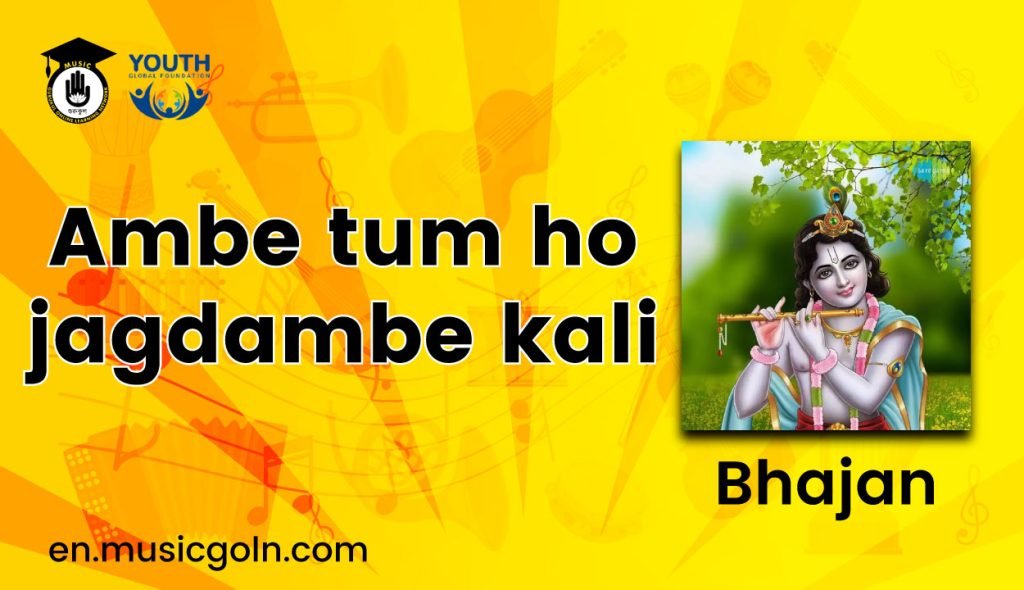Ambe tum ho jagdambe kali lyrics | Bhajan
Bhajan refers to any devotional song with a religious theme or spiritual ideas, specifically among Indian religions, in any language.The term bhajanam (Sanskrit: भजनम्) means reverence and originates from the root word bhaj (Sanskrit: भज्), which means to revere, as in ‘Bhaja Govindam’ (Revere Govinda). The term bhajana also means sharing.
Ambe tum ho jagdambe kali lyrics | Bhajan
Ambe tum ho jagdambe kali lyrics :
Ambe Tu Hai Jagdambe Kali, Jai Durge Khappar Wali ।
Tere Hi Gun Gaaye Bharati, O Maiya, Hum Sab Utarey Teri Aarti ॥
Tere Jagat Ke Bhakt Janan Par, Bhid Padi Hai Bhari Maa ।
Daanav Dal Par Toot Pado, Maa Karke Singh Sawari ।
So-So Singho Se Tu Balshali, Asth Bhujao Wali,
Dushton Ko Pal Mein Sangharti ।
O Maiya, Hum Sab Utarey Teri Aarti ॥
Maa Bete Ka Hai Ish Jag Mein, Bada Hi Nirmal Nata ।
Poot Kaput Sune Hai Par Na, Mata Suni Kumata ॥
Sab Par Karuna Darshaney Wali, Amrut Barsaney Wali
Dukhiyon Ke Dukhdae Nivarti ।
O Maiya, Hum Sab Utarey Teri Aarti ॥
Nahi Maangtey Dhan Aur Daulat, Na Chaandi Na Sona Maa ।
Hum To Maangey Maa Tere Man Mein, Ek Chota Sa Kona ॥
Sabki Bigdi Banane Wali, Laaj Bachane Wali,
Satiyo Ke Sat Ko Sanvarti ।
O Maiya, Hum Sab Utarey Teri Aarti ॥
The term ‘bhaj’an’ is also commonly used to refer a group event, with one or more lead singers, accompanied with music, and sometimes dancing. Normally, bha’jans are accompanied by percussion instruments such as tabla, dholak or a tambourine. Handheld small cymbals (kartals) are also commonly used to maintain the beat. A bha’jan may be sung in a temple, in a home, under a tree in the open, near a river bank or a place of historic significance.
Having no prescribed form, or set rules, bha’jans are normally lyrical and based on melodic ragas. It belongs to a genre of music and arts that developed during the Bhakti movement. It is found in the various traditions of Hinduism as well as Jainism. Within Hinduism, bhaj’ans are particularly prevalent in Vaishnavism.
Ideas from scriptures, legendary epics, the teachings of saints and loving devotion to a deity are typical subjects in bha’jans.
Bhaja’ns have been widely composed anonymously and shared as a musical and arts tradition. Genres such as Nirguni, Gorakhanathi, Vallabhapanthi, Ashtachhap, Madhura-bhakti and the traditional South Indian form Sampradya Bha’jan each have their own repertoire and methods of singing.
he Sanskrit word bhaja’n or bha’jana is derived from the root bhaj, which means “divide, share, partake, participate, to belong to”.The word also connotes “attachment, devotion to, fondness for, homage, faith or love, worship, piety to something as a spiritual, religious principle or means of salvation”.
Read More :
- Karte ho tum kanhaiya lyrics | Bhajan
- Khud Ko Tere Lyrics | Mahalakshmi Iyer | 1920 Evil Returns | 2012
- Anjane ho tum jo lyrics | Sonu Nigam | 1920 Evil Returns | 2012
- Hum Bhi Akele Lyrics | Salaam Memsaab | Asha Bhosle, Mohammed Rafi | 1979
- Tum bhi kar key Unka charcha Lyrics | Naat
- Tum Agar Saamne Lyrics | Raaz | Alka Yagnik, Abhijeet | 2002
- Ruth Gaye More Shyaam lyrics | Ziddi | Lata Mangeshkar | Ziddi | 1948
